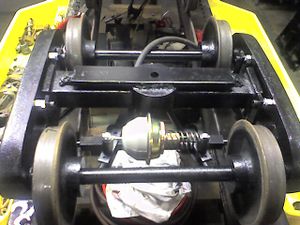Vacuum brakes
Jump to navigation
Jump to search
Vacuum brakes have been favored in the past with trains headed by a live steam locomotive. A simple steam-driven ejector can quickly develop a significant vacuum to apply the brakes. No storage tanks are required.
Mike Massee wrote:
- In New Zealand, most clubs have standardized on steam vacuum brakes via the use of a steam ejector. The problem with this if a novice engineer runs low on steam, the ejector also stops working.
- Clubs use them a lot - they are standard at PLS and work just fine. We started the hobby in 3/4 inch using vacuum brake systems that Carl Purinton copied from the British, so us 'smaller scale' guys are very familiar with their operation.
- Most all the vacuum cylinders I've seen in use are about 4" in diameter. They have to be that large to get any appreciable force from them as the maximum pressure available is 30 inch of Mercury, i.e. 15 PSI.
- The vacuum system must use relatively large lines because of the larger volume of air that must be moved and the very low pressures involved. Large line volume, high volume of air to be moved, low pressure = considerable delay in application time.
